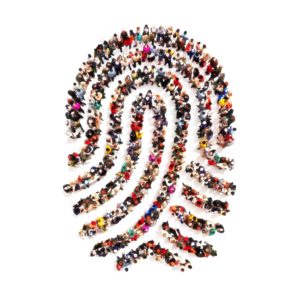With Mobile World Congress now underway for another year, we thought we’d take a dive into how companies and governments are approaching digital identity.

In this blog, I’m joined by my colleague Didier Benkoel-Adechy as we chat through some of the most pressing questions on the topic.
How has the digital economy changed the way we think about identity? Has there been an impact on the way companies interact with consumers?
Juana Catalina Rodriguez (JCR): The Internet and the widespread connectivity has enabled the explosion of new collaboration models. This has resulted in a series of exciting technological breakthroughs from Uber testing autonomous cars to Facebook developing cryptocurrency for its users to make payments through WhatsApp. Even Amazon is getting in on the act by planning to launch 3,000 “Amazon-Go” cashier-less stores by 2021.
Didier Benkoel-Adechy (DB): It’s interesting isn’t it how these innovations have revolutionized the way companies in all sectors interact with consumers. It’s been said before but we’re now much more comfortable interacting with these networks of strangers.
JCR: That’s right, and those interactions are built on trust. In this new era, the first thing we want to know is whether that person or service is “real”. We’re now questioning how sure we can be that others are who they claim to be.
Where I have concerns is that this shift from in-person transactions to digital connections is creating a new dynamic environment which could inspire insecurity and fear.
Traditional identification methods don’t work, as a result, we are changing the way we think about identity.
DB: And that’s where Gemalto’s Trusted Digital Identities approach comes in. It can be a decisive factor for success for companies who need to offer their customers trust. And we mustn’t forget that increased safety and transparency are the most fundamental elements needed to make the most from this new digital era.
JCR: Every day we are working with services providers and governments to design new customers experiences. It is vitally important that we meet the end-user need for consistent, seamless and personalized engagement across a range of digital and physical channels. It has become clear that digital identities are the strategic foundation of digital business transformation.
Is there a difference in how digital identity is used in emerging markets vs developed markets?
JCR: You’d be surprised at how much identity underpins the digital revolution and, by extension, world economies.
We see different levels of maturity per country, market and sector. Neo/challenger/digital-only banks are using online document verification and biometrics to enable remote mobile enrolment.
DB: And then there are countries like India where digital identities supported by biometric technology is providing access to communities previously cut-off from financial services.
Digital identity provides a significant opportunity for value creation for individuals and institutions. For emerging economies, a lot of value creation can be generated by combining digital ID with authentication. This has the power to transform the lives of people who lack an official proof of identity. And the World Bank estimates that’s as much as one billion people.
JCR: I’ve been struck by transformative affect digital identities has had in these countries. It goes way beyond reducing the cost of current operations. Improving ID coverage give people more access to education, boosts the labor market and makes healthcare more accountable. But it also goes beyond purely economic factors in boosting how citizens feel included in society, have their rights protected and raises transparency (which inevitably tackles corruption).
DB: Looking at developed markets as UK, France, Denmark, Netherlands, Belgium, many processes are already digital. The potential for improvement here relies on digital ID programs that enable seamless experiences across multiple channels to access more services and further reduce customer friction.
What key elements does a digital identity need to have?
JCR: A digital identity is the technological link between a real entity such as a person and its digital equivalent entities. It is also defined as the sum of all digitally available information about an individual. It includes a collection of verified identity attributes such as biographic and biometric data, known passwords, digital codes and also owned devices. These can all come together in various contexts to verify and authenticate a person.
Can you discuss security and privacy for a moment? What are some of the risks associated with digital identities and how can companies mitigate those risks to ensure consumer trust?
DB: Absolutely, both must be at the center of any digital identity system. We subscribe to an idea of security by design and are very focused on privacy. There is a lot out there lately suggesting that people want greater ownership of their data and to know the services they use are secure.
JCR: As we all know, there has been a significant rise in complaints of social media user data misuse. Facebook, in particular, made headlines last year with numerous high-profile data breaches including the Cambridge Analytical scandal. When it comes to
consumer privacy, I consider there to be three fundamental elements to take into account:
- Consumers need to know what information of theirs is stored, how it is protected and the ways it is used.
- Consumers must have control of their data, explicitly give their consent for its use and be able to easily manage their privacy options.
- Digital identities must be driven by human-centric design to reduce friction and fulfil their potential.
DB: That’s true. Designing services with these factors in mind will increase trust, improve adoption and heighten transparency. And it will also calm end-user nerves about their privacy being eroded by using new services.
JCR: To some extent, the combination of technologies and digital identities could be seen as a double-edged sword. All ecosystems are concerned about how data can be misused for monetization and how easy it is for identities to be stolen, replicated, curated and morphed for fraud. But it is the addition of Trusted to the Digital Identity concept that proves essential for ensuring security and privacy.
We are working “for the good” of the industry and technologies like biometrics, big data and AI will lead to vast opportunities for new innovative services that will delight end users.
If you would like more information about how Gemalto seamlessly capture and verify user identities, and how we digitalize them securely, you can click here or, alternatively, you can tweet us @Gemalto


